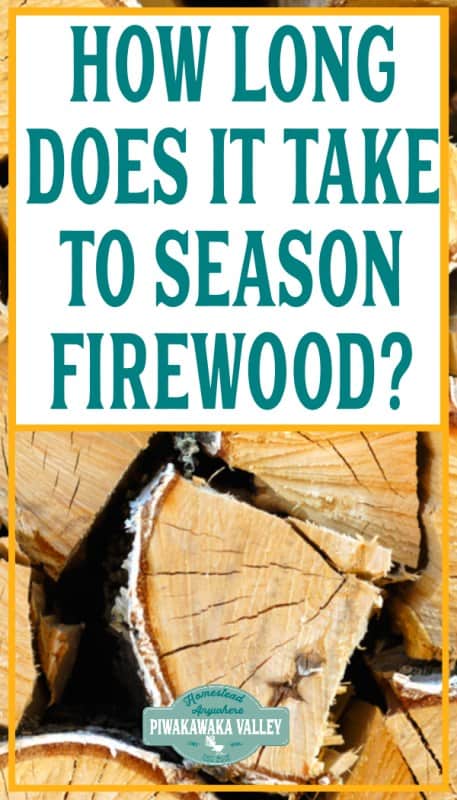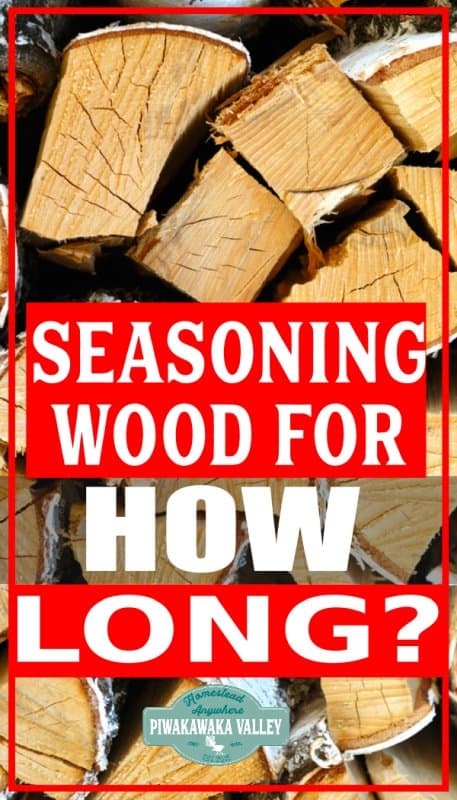This post was most recently updated on July 6th, 2021
Well seasoned firewood will burn hot, long and cleanly in your fireplace or fire pit. Getting your fire wood dry enough for this to be the case depends on many factors, but many people ask how long does it take to season firewood.
Please read: This information is provided for educational purposes only and is not intended to treat, diagnose or prevent any disease. We encourage you to make your own health care decisions in partnership with a qualified health care professional.
This post contains affiliate links, this means at no extra cost to you, we make a commission from sales. Please read our Disclosure Statement
How long does it take to season firewood?
The answer is, it depends on several factors. Generally speaking, most common fire wood options will dry well in 6-9 months, given good drying conditions. Firewood is considered “well seasoned” once the moisture levels get below 20% but there are many variables that will affect how long it takes for a log of firewood to get to that level.
Hardwood vs Softwood
The longest-burning firewood that produces the most heat will be a hardwood.
But, just to be confusing, the term “hardwood” doesn’t necessarily mean it’s a wood that is hard to the touch. Balsa, a very light, easy-to work wood, is actually a hardwood.
Hardwoods are defined as being trees that reproduce by producing seed with some sort of covering over them (eg, acorn, apple, walnut), and are deciduous. Hardwood is usually heavier and more dense than soft woods and they therefore take longer to dry. Oak can take up to 2 years to dry properly.
Softwoods are evergreen and their seeds have no covering, like pine or willow trees. The reason people use them is because they tend to be easier to cut and split, and soft wood logs dry more quickly – in about 6-12 months.
Soft wood burn much faster than hardwoods so you need around twice as much to get the same amount of heat.
However, softwoods do have their place and I like to get a mix of hard and soft wood. Softwood burn more easily so you can use them as the starting base wood of a fire to get it hot quickly, then add hardwoods to keep the heat going for a long time.
RELATED: How to light a fire without kindling
Seasons
Trees cut once the sap starts running in spring will have more sap in them and they will take a little longer to dry than wood cut in the winter when the sap is less liquid.
Trees in colder areas dehydrate their sap slightly over winter to reduce the risk of damage from hard freezes. However, it is unlikely you are going to feel much like felling trees in the middle of winter.
Wind and rain as well as sun help to dry out cut, split and stacked wood. Rain helps wash out the sap, which can slow down drying times.
Wind and sun help dry the wood from both water and sap. Stack your wood somewhere that the ends can be exposed to wind and sun as much as possible to speed up the drying process.
RELATED POST: How to dry your wood FAST
Log Size
Firewood dries from the ends not the sides. So the fastest way to season your firewood is to cut it in to short lengths, or rounds.
To ensure it fits well in to your fire, measure your firebox and cut your rounds to about 1 inch less than the length of your fire box.
Cutting your wood shorter than this will speed up drying time, but increase the number of logs you will need to cut, split, stack and cart inside. Best to make it the optimal size for your firebox and save yourself too much work.
The center of the log is the last to dry out, so keep your pieces to about 10cm/4 inches in diameter to speed this up.
RELATED POST: How to tell if your firewood is seasoned yet
RELATED POST: How to dry your wood FAST
Can firewood be too old or too dry?
It’s not necessarily the age of your firewood that you have to worry about – it is more about the amount of moisture within the wood.
Old wood kept in damp conditions will still be damp no matter how old it is. It is more likely to rot over time if it is kept damp, so it has a limited life span in that regard.
Wood does dry over time so one could assume after many years, the moisture level will be really low. If you keep your wood somewhere with low humidity like in a hot, dry shed, then it can get very very dry.
However, keeping your firewood outside, exposed to natural humidity, usually keeps the moisture content of the wood above 10% (depending on your local climate).
The dryer the wood is, the faster it will burn. If it is in a contained fireplace, this is not a problem, just damper the fire down and let it do its thing. If you are using it outside for a bonfire or firepit, with enough airflow, the fire can get out of hand.
Burning really dry wood can be problematic in some circumstances, but its usually not an issue.
Can I burn Wet or Green Firewood?
Technically, yes you can burn it. But it is not recommended for several reasons:
- It is really hard to light on fire
- It is really hard to keep burning
- You will get very little heat from it as it is using the energy to dry off
- It makes a lot of steam, smoke, creosote and ash
If you are in a survival situation and you need a fire to keep warm, you can burn green wood. But it won’t be easy or pleasant. If you have the ability to source dry, well seasoned wood, you will thank yourself for it.
Common firewood types and how long they take to dry
Here are the most common firewood types and how long they will take to be properly seasoned once cut to a suitable size to burn in a home fire.
| Type of Wood | Time to season | Million BTU per cord |
|---|---|---|
| Oak | 12 to 24 months | 24 |
| Hickory | 12 to 18 months | 28.5 |
| Apple | 12 to 28 months | 26.6 |
| Birch | 6 to 9 months | 20 |
| White Ash | 6 months | 23.6 |
| White Pine | 5 to 8 months | 14.3 |
| Oregon | 6 to 12 months | 20 |
| Macrocarpa (Monterey cypress) | 6 to 12 months | 21 |
| Eucalyptus | 8-18 months | 34.5 |
Gorse – can be burned green as the sap burns well HOT. To dry it takes 8-18 months depending on size and age.
As you can see, planning ahead is your best tool for ensuring that your wood is dry and well seasoned by winter. If you have the space, having a wood shed that will hold two or more years worth of firewood would be ideal.
Or, alternatively, store next years wood outside to weather and dry and this years wood in the wood shed in the spring time to finish drying well before the colder weather sets in.
RELATED POST: What is the best types of firewood?
RELATED POST: Starting a fire without Newspaper
How much firewood do you need?
This is a really difficult question to give you a simple answer for.
Your firewood use depends on various factors including your climate, your fire, the type of wood, and your personal warmth expectations.
In New Zealand our wood is sold by the tossed cubic metre. This is not a good way to measure wood, and you do loose about 33% or a third by volume when you stack it properly. In America and elsewhere in the world, they sell wood by the cord which is a stacked volume measurement 4 foot x 4 foot x 8 foot, or 1.2m x 1.2m x 2.4m making a total of 128 cubic feet or 3.45 cubic meters.
Your Climate
You will need to work out how many weeks of the year that you will be burning wood for. Where we are we generally seldom use the fire after October, and usually re-start using it in April meaning there are about 26 weeks we use it, and 26 weeks that we don’t.
Types of Fireplace
Your firewood consumption varies greatly depending on the type of fireplace or stove in use. For an average burning timber like macrocarpa or birch you can expect:
Open Fires
An ideal baseline is to figure 1 cord per 7 full days of burn for a large open fireplace that does not have any air restriction devices installed.
Non-catalytic Fires
Non-catalytic wood stoves will use 1 cord every 30 to 60 days.
Catalytic Fires
Catalytic wood stoves will use 1 cord per season for very high efficiency models.
Types of wood
Soft woods burn cooler and faster, harder woods burn hotter and longer. You can often get a mix of several types of wood to make the most of both of these options.
If you burn soft wood you may need as much as twice the volume of hard wood.
To demonstrate this, when we first moved in we had white pine from when we cleared to put in the house. We were burning 4 tubs of this per day. Once it was finished we used the dry eucalyptus that we had from the year before and we only burned 2 tubs of it a day.
Then we had a small volume of gorse wood that we had cleared off our section and it was so good and hot we only had to burn one tub of it a day, but we needed some softer wood to get the fire started because the fire had to be quite hot before the gorse would catch fire.
Personal Preference
Houses vary widely in how much heat they retain and how much heat they need produced to keep them at the reasonable temperature. Also, what constitutes “reasonable temperature” varies depending on your preference.
We only put the fire on if the temperature drops below 18 Celsius in the living room, others may have a much warmer threshold.
A good place to start
A rule of thumb is for an average 100m2/1000sqft home in a not too cold of a climate will need about 3 cords or 10m3 of wood. This is a good place for most people to start.
If you have the space, aim to get twice this and measure how much you have left at the end of a winter. The you can use this as a reference for the following year, allowing an extra 20% of so in case of a colder year.


